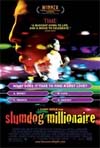The
Curious Case of Benjamin Button
Fantastic Mr. Fox
Gran Torino
Harry Potter and the Half Blood Prince
The Hurt Locker
The
Informant!
Julie and Julia
Milk
The Reader
Serious Man
Film Reviews from 2008
Film
Reviews from 2007
Film Reviews
from 2006
Slumdog Millionaire
I admit to having difficulty warming up to Slumdog. In the opening moments, police brutally torture Jamal, during a break in his spectacular run on India’s version of Who Wants To Be a Millionaire? They simply cannot believe that an orphan from the slums could do so well on the quiz show without cheating. From this point, the film takes us back to Jamal’s childhood, including his mother’s death. Along with his brother Salim, Jamal survives by begging, stealing, and working occasional odd jobs, along with a combination of luck and sheer willpower. Along the way, Jamal is smitten by the lovely young orphan Latika. Latika continues to appear and disappear throughout Jamal’s journeys, until she becomes an obsession with him.
Even though he is not Indian, Boyle uses some of the elements of “Bollywood” the Hollywood of India: bright, garish colors, fast editing, a sweeping score, and even a concluding dance sequence, to tell Jamal’s story. Jamal is the young innocent who somehow survives the elements of poverty, crime, and racism, without ever losing his virtue. Indian actor Dev Patel gives a wonderfully understated performance as Jamal, with his dark sad eyes taking in everything. He never reacts with the hysterical excitement expected of game show contestants. Beneath Jamal’s quiet resolve is that which has driven him throughout his life: a steadfast will to survive and be reunited with Lolita. Who wouldn’t root for him? As a popular entertainment, Slumdog Millionaire is a great success, despite my initial reservations. Like the novels of Dickens, Boyle and Beaufoy tell a popular, engaging story, while, at the same time, exposing poverty, crime, corruption, and prejudice. One of the great underlying themes in the film is the prejudice against Jamal. How could someone like him do so well on the game show? Who would we harbor the same thoughts against in our own culture, automatically assuming the worst? Think about this while you enjoy the colorful adventures of Jamal. The film will win you over, as it will no doubt win over Oscar voters this year. Don’t leave the theater to soon; the music/dance number against the closing credits is a Bollywood delight.
Tom Condon, OP
|
2009 Best Picture
|



 Slumdog
Millionaire is an Indian film which is fast becoming a big hit
in the U.S. It will probably become the most widely seen Indian
film ever in this country. It’s not hard to see why it
is so popular. This sprawling tale of Jamal Malik, an orphan
who overcomes major obstacles in order to become a national hero, is
being compared to the works of Dickens or Voltaire. Slumdog has
the elements of a classical tale with universal appeal, yet its context
is unmistakably Indian. With its terrible poverty and cast system
contrasted to new wealth and technology, from garbage dumps to the
Taj Mahal to the technological center of Mumbai, the country of India
is a much of a character in the film as any actor.
Slumdog
Millionaire is an Indian film which is fast becoming a big hit
in the U.S. It will probably become the most widely seen Indian
film ever in this country. It’s not hard to see why it
is so popular. This sprawling tale of Jamal Malik, an orphan
who overcomes major obstacles in order to become a national hero, is
being compared to the works of Dickens or Voltaire. Slumdog has
the elements of a classical tale with universal appeal, yet its context
is unmistakably Indian. With its terrible poverty and cast system
contrasted to new wealth and technology, from garbage dumps to the
Taj Mahal to the technological center of Mumbai, the country of India
is a much of a character in the film as any actor. Adapting
the novel, Q & A, British director Danny Boyle (whose 2005
film Millions is one of my favorite spiritual films) along with
screenwriter Simon Beaufoy, bring Jamal’s story to life. Boyle
intersperses disturbing scenes of poverty and some violence with intimate
moments, and offbeat humor. The fast pace builds to the incredible suspense
of Jamal on the set of Millionaire. No one expects Jamal
to do well on the show, from the producers to an unscrupulous host to
the police. After all, he is only a poor “slumdog;” how
could he know the right answers without somehow cheating?
Adapting
the novel, Q & A, British director Danny Boyle (whose 2005
film Millions is one of my favorite spiritual films) along with
screenwriter Simon Beaufoy, bring Jamal’s story to life. Boyle
intersperses disturbing scenes of poverty and some violence with intimate
moments, and offbeat humor. The fast pace builds to the incredible suspense
of Jamal on the set of Millionaire. No one expects Jamal
to do well on the show, from the producers to an unscrupulous host to
the police. After all, he is only a poor “slumdog;” how
could he know the right answers without somehow cheating?